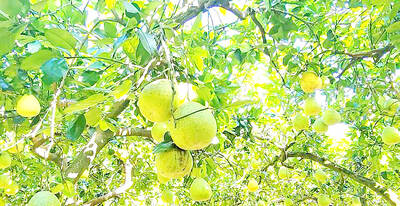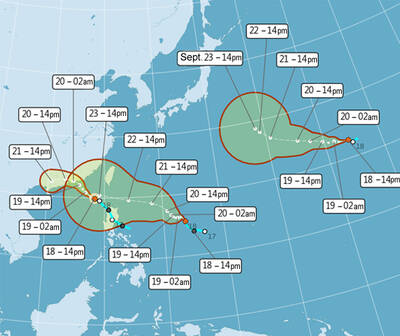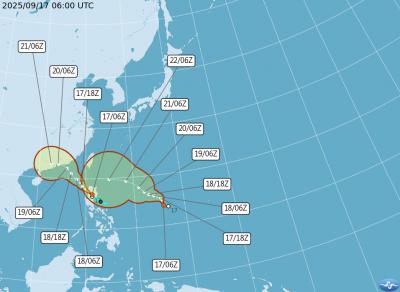Almost 59 percent of residential properties in Taiwan are more than 30 years old, Ministry of the Interior data showed.
As of the second quarter, 5.54 million of the nation’s more than 9.4 million residential units were at least 30 years old, accounting for 58.94 percent of the total, data from the ministry’s Real Estate Information platform showed.
The figure represented an increase of nearly 400,000 homes aged 30 years or older from the previous quarter — a nearly 4 percentage point rise in just three months.

Photo: Taipei Times
The high proportion of aging buildings stems largely from difficulties in rebuilding or renovating properties, H&B Realty chief researcher Ho Shih-chang (何世昌) said on Sunday.
Many homeowners view new residential units as smaller than current properties, with higher shared facility fees and heavier tax burdens, making them reluctant to move to a newer property, he said.
Cities with more redevelopment zones and large volumes of new housing projects tend to have a lower share of aging homes, the ministry data showed.
New Taipei City has the most older residential properties — nearly 950,000 — due to its vast housing stock, while Taipei has the highest ratio among the six special municipalities, a result of limited new redevelopment zones, it said.
If the pace continues, the number of homes in New Taipei City that are more than 30 years old is likely to surpass 1 million by the end of the year, it said.
Kaohsiung reported more than 690,000 old homes in the second quarter, followed by Taipei and Taichung, each with about 600,000 old homes. Tainan and Taoyuan had fewer than 500,000 each, while Taoyuan had the fewest of the special municipalities at just more than 420,000 units.
Tseng Ching-te (曾敬德), a manager at Sinyi Realty’s research center, said that areas with many redevelopment zones are better able to add large volumes of new housing, provided there is sufficient demand.
However, many homes in Taiwan are older-style apartment buildings without elevators, which is why the stock of aging units keeps rising, particularly in Taipei, which lacks large-scale redevelopment areas, he said.
Taipei had the highest proportion of older houses in the second quarter at nearly 74 percent — or one in every 1.35 homes in the city. In Tainan and Kaohsiung, older homes accounted for more than 60 percent of the total, while Taoyuan was the only one of the six municipalities with a share below 50 percent, at about 45 percent.
Colliers International Taiwan director Huang Shu-wei (黃舒衛) said that homes older than 30 years are often not as earthquake-resistant as newer properties, and might sustain structural issues due to repeated strong quakes, adjacent construction or later modifications.
Older buildings have outdated or nonexistent elevators, and limited fire safety equipment, as well as issues with pipes and leaks, he said.
With an aging population, the demand for safer and more accessible housing is growing, he said.

NEW AGREEMENT: Malaysia approved imports last year after nearly two years of negotiations and inspections to meet quarantine requirements, officials said Up to 3.6 tonnes of pomeloes from Taiwan cleared Malaysian customs on Friday, in the first shipment of Taiwanese pomeloes to Malaysia. Taiwan-grown pomeloes are popular in domestic and overseas markets for their tender and juicy taste, the Ministry of Agriculture’s Animal and Plant Health Inspection Agency said. The fruit is already exported to Japan, Canada, Hong Kong, Singapore and the Philippines, it added. The agency began applying for access to the Malaysian market in 2023, compiling data on climate suitability, pests and diseases, and post-harvest handling, while also engaging in nearly two years of negotiations with Malaysian authorities and submitting supplementary

PEAK MONTHS: Data showed that on average 25 to 27 typhoons formed in the Pacific and South China seas annually, with about four forming per month in July and October One of three tropical depressions in the Pacific strengthened into a typhoon yesterday afternoon, while two others are expected to become typhoons by today, Central Weather Administration (CWA) forecaster Lee Ming-hsiang (李名翔) said yesterday. The outer circulation of Tropical Depression No. 20, now Typhoon Mitag, has brought light rain to Hualien, Taitung and areas in the south, Lee said, adding that as of 2pm yesterday, Mitag was moving west-northwest at 16kph, but is not expected to directly affect Taiwan. It was possible that Tropical Depression No. 21 would become a typhoon as soon as last night, he said. It was moving in a

One of two tropical depressions that formed offshore this morning could turn into a moderate typhoon by the weekend, the Central Weather Administration (CWA) said today. Tropical Depression No. 21 formed at 8am about 1,850km off the southeast coast, CWA forecaster Lee Meng-hsuan (李孟軒) said. It is expected to move in a northwesterly direction as it continues building momentum, possibly intensifying into Typhoon Mitag this weekend, she added. The radius of the storm is expected to reach almost 200km, she said. It is expected to approach southeast of Taiwan on Monday and pass through the Bashi Channel between Tuesday and Wednesday,

About nine Taiwanese are “disappeared,” detained, or otherwise deprived of freedom of movement in China each month, the Mainland Affairs Council (MAC) said yesterday. Between Jan. 1 last year and Aug. 31 this year, 188 Taiwanese travelers went missing, were detained and interrogated, or had their personal freedom restricted, with some questioned in airports or hotel lobbies, the council said. In a statement ahead of the Mid-Autumn Festival, the council urged people visiting China for any reason to be highly vigilant and aware of the risks. Of the reported cases, 50 people were “disappeared” after entering China, 19 were detained and 119 had